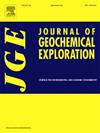Fe, Cu and S isotopes as tracers of microbial reduction in the shale-hosted VMS deposits of the Iberian Pyrite Belt
IF 3.3
2区 地球科学
Q1 GEOCHEMISTRY & GEOPHYSICS
引用次数: 0
Abstract
This study represents an exploration of the geochemistry of sulphide minerals from prominent shale-hosted volcanogenic massive sulphide deposits of the Iberian Pyrite Belt, including Sotiel-Migollas, Tharsis, Neves Corvo and Lousal using the non-traditional heavy stable isotopes of Fe and Cu along with the S light isotope. Sampling encompassed a diverse range of styles of mineralization, including the dominant fine-grained massive sulphides sometimes exhibiting sedimentary layering, carbonate-rich mounds dominated by sulphides-siderite and formed by the superposition of microbial mats in anoxic bottoms, underlying subseafloor feeder structures (stockworks) and disseminated pyrite within the altered host shales. The δ56FeIRMM-014 values of pyrite exhibit a range from −2.62 to +2.58 ‰, while those of pyrrhotite range from −1.93 to −0.40 ‰. Chalcopyrite δ65CuSRM-976 signature varies between −1.11 and + 0.95 ‰, while the measured δ34SV-CDT values fluctuate from −45.0 to +9.4 ‰ in pyrite, −6.8 to +2.1 ‰ in pyrrhotite, and − 10.1 to +6.2 ‰ in chalcopyrite. Notably, pyrite grains within massive sulphides consistently exhibit more negative and variable δ56Fe and δ34S values than those in the hydrothermally altered host shales (apart from Neves Corvo) and stockworks. These findings strongly imply that the exhalative mineralization incorporated substantial amounts of iron derived from the dissimilatory reduction of aqueous Fe+3, attributable to low-temperature (<100–120 °C) microbial reduction and contemporaneous with biogenic sulphate reduction. Consequently, Fe in pyrite is likely inherited from both the reduced hydrothermal fluids venting on the seafloor and the microbial reduction of oxidized iron dissolved in ambient seawater. While the microbial influence on Cu isotope signatures is less evident, we infer its potential significance. Superimposed hydrothermal refining during the late percolation of hot hydrothermal fluids reveals a non-biogenic kinetic fractionation, with partial overprinting of the early mineralization and neoformation of sulphides depicting isotopically heavy δ56Fe, δ65Cu, and δ34S signatures that are interpreted as of deep derivation.

伊比利亚黄铁矿带页岩VMS矿床中Fe、Cu和S同位素的微生物还原示踪
本研究对伊比利亚黄铁矿带(包括Sotiel-Migollas、Tharsis、Neves Corvo和Lousal)著名页岩火山岩块状硫化物矿床的硫化物矿物进行了地球化学探索,使用了Fe和Cu的非传统重稳定同位素以及S轻同位素。样品包含了多种类型的矿化,包括主要的细粒块状硫化物(有时表现为沉积分层),以硫化物-菱铁矿为主的富含碳酸盐的土丘(由缺氧底部的微生物席叠加形成),潜在的海底馈线结构(stockworks)和蚀变的主页岩内的浸染黄铁矿。黄铁矿的δ56FeIRMM-014值为−2.62 ~ +2.58‰,磁黄铁矿的δ56FeIRMM-014值为−1.93 ~−0.40‰。黄铜矿δ65CuSRM-976特征值在- 1.11 ~ + 0.95‰之间变化,黄铁矿δ34SV-CDT值在- 45.0 ~ +9.4‰之间变化,磁黄铁矿δ 6.8 ~ +2.1‰之间变化,黄铜矿δ34SV-CDT值在- 10.1 ~ +6.2‰之间变化。值得注意的是,块状硫化物中黄铁矿颗粒的δ56Fe和δ34S值始终比热液蚀变的储集页岩(Neves Corvo除外)和储集层中黄铁矿颗粒的δ56Fe和δ34S值更负且变化更大。这些发现有力地表明,由于低温(100-120°C)微生物还原和同时发生的生物硫酸盐还原,呼出矿化过程中包含了大量来自水中Fe+3的异化还原的铁。因此,黄铁矿中的铁可能继承自海底热液喷口的还原作用和周围海水中氧化铁的微生物还原作用。虽然微生物对Cu同位素特征的影响不太明显,但我们推断其潜在意义。热液流体渗流后期的叠合热液精炼作用显示出非生物成因的动力学分馏作用,部分叠合早期成矿作用和新形成的硫化物表现出同位素重的δ56Fe、δ65Cu和δ34S特征,解释为深部衍生。
本文章由计算机程序翻译,如有差异,请以英文原文为准。
求助全文
约1分钟内获得全文
求助全文
来源期刊

Journal of Geochemical Exploration
地学-地球化学与地球物理
CiteScore
7.40
自引率
7.70%
发文量
148
审稿时长
8.1 months
期刊介绍:
Journal of Geochemical Exploration is mostly dedicated to publication of original studies in exploration and environmental geochemistry and related topics.
Contributions considered of prevalent interest for the journal include researches based on the application of innovative methods to:
define the genesis and the evolution of mineral deposits including transfer of elements in large-scale mineralized areas.
analyze complex systems at the boundaries between bio-geochemistry, metal transport and mineral accumulation.
evaluate effects of historical mining activities on the surface environment.
trace pollutant sources and define their fate and transport models in the near-surface and surface environments involving solid, fluid and aerial matrices.
assess and quantify natural and technogenic radioactivity in the environment.
determine geochemical anomalies and set baseline reference values using compositional data analysis, multivariate statistics and geo-spatial analysis.
assess the impacts of anthropogenic contamination on ecosystems and human health at local and regional scale to prioritize and classify risks through deterministic and stochastic approaches.
Papers dedicated to the presentation of newly developed methods in analytical geochemistry to be applied in the field or in laboratory are also within the topics of interest for the journal.
 求助内容:
求助内容: 应助结果提醒方式:
应助结果提醒方式:


